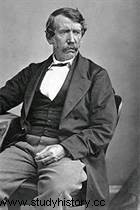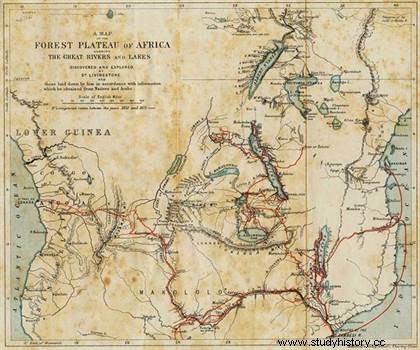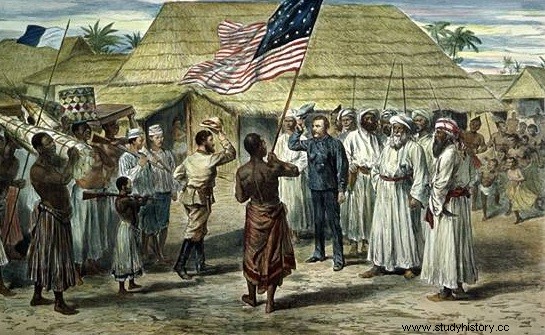 Scottish physician and missionary to South Africa, David Livingstone undertakes, from 1849, various expeditions in central and southern Africa, during which he recognizes the course of the Zambezi and its tributary, discovers several lakes and contributes to solving the enigma of the source of the Congo. in the 19th century by Europeans (except for the slave trade), the African continent aroused the interest of Western colonial powers and the curiosity of intrepid explorers and cartographers, such as the famous Doctor Livingstone , who hoped to discover the sources of the Nile. He is probably the first European to have crossed the African continent from East to West.
Scottish physician and missionary to South Africa, David Livingstone undertakes, from 1849, various expeditions in central and southern Africa, during which he recognizes the course of the Zambezi and its tributary, discovers several lakes and contributes to solving the enigma of the source of the Congo. in the 19th century by Europeans (except for the slave trade), the African continent aroused the interest of Western colonial powers and the curiosity of intrepid explorers and cartographers, such as the famous Doctor Livingstone , who hoped to discover the sources of the Nile. He is probably the first European to have crossed the African continent from East to West.
David Livingstone, missionary and explorer
Born March 19, 1813 in Blantyre, near Glasgow, David Livingstone, one of Africa's most famous explorers, came from a poor Scottish family . From the age of 10, he worked in a cotton factory, but spent his free time taking evening classes. Intelligent and diligent, he read many travelogues, which stimulated his imagination. A man of great faith, he discovered a vocation as an evangelist at the age of 19 and managed to obtain a scholarship to study theology and medicine at the University of Glasgow. In 1838, he joined the Missionary Society of London, which sent him three years later to Africa. After a stay in Cape Town, he went to the protectorate of Bechuanaland (now Botswana).
 Livingstone begins his work among the Africans of Bechuanaland, trying to move north despite the hostility of the Afrikaners, white colonizers of Dutch origin. Accompanied by his wife, he crossed regions that had never before been explored by Europeans:in 1849 in particular, Livingstone crossed the Kalahari desert and discovered Lake Ngami, then the Zambezi in 1851.
Livingstone begins his work among the Africans of Bechuanaland, trying to move north despite the hostility of the Afrikaners, white colonizers of Dutch origin. Accompanied by his wife, he crossed regions that had never before been explored by Europeans:in 1849 in particular, Livingstone crossed the Kalahari desert and discovered Lake Ngami, then the Zambezi in 1851.
During a new expedition (1852-1856), while looking for a passage from the east or west coast to the interior of the country, he went north , from the Cape to the Zambezi, then west to Luanda on the Atlantic coast, then discovered the Kasai in 1854. He then descended the Zambezi to its mouth on the Indian Ocean, discovering on the way, in November 1855, gigantic waterfalls, which the locals call "the thundering smoke", which he named Victoria in honor of the Queen of England.
Discovering East Africa
Returning to Britain in 1856, Livingstone is considered a great explorer; his discoveries led to the revision of all the maps of the time (see cartography) and his work Missionary Travels and Researches in South Africa (1857) — translated into French in 1859, under the title Explorations dans l'intérieur de l'Afrique austral , and travels across the continent, from Saint-Paul de Loanda to the mouth of the Zambezi (1840-1856) — made him famous. He left the association of missionaries and in 1858 the British government appointed him British consul for the east coast of Africa at Quelimane (in present-day Mozambique), with the task and objective of exploring South Africa. East and Central Africa.
As soon as he returned to Africa in 1858, Livingstone led an expedition upstream of the Chiré, a tributary of the Zambezi, during which he discovered, two centuries after the first Portuguese explorers, Lake Malawi then, in 1859, the Rovuma River and Lake Chilva. Deeply affected by the behavior of Arab and Portuguese slaveholders towards Africans, Livingstone wrote in 1865, during a new stay in England, a work condemning the slave trade and exposing the economic possibilities of the region (today the largest part of Malawi and Mozambique).
Livingstone and the quest for the sources of the Nile
In 1866, benefiting from the financial support of his friends and admirers, Livingstone was able to set out again to discover the sources of the Nile and the watershed line in Central Africa separating the Nile and Congo basins. Along the Rovuma River, the explorer headed for Lake Tanganyika, which he reached in 1869 after discovering Lakes Mweru and Bangweulu. For several months, Livingstone, now based in Ujiji, on Lake Tanganyika, gave no sign of life, and the whole world wondered about his disappearance. Then, in 1870, he launched reconnaissance towards the region west of the lake and reached Lualaba (in the current Democratic Republic of the Congo).
 After a period of great deprivation, he returned to Ujiji where he was joined in November 1871 by a rescue team of the New York Herald, driven by Henry Morton Stanley, an Anglo-American journalist who is said to have greeted the explorer with the famous remark "Doctor Livingstone, I presume? ". Stanley and Livingstone together explore the region north of Lake Tanganyika. Then the Scottish explorer set off again in search of the sources of the Nile, a journey testified to in his Diary, published after his death.
After a period of great deprivation, he returned to Ujiji where he was joined in November 1871 by a rescue team of the New York Herald, driven by Henry Morton Stanley, an Anglo-American journalist who is said to have greeted the explorer with the famous remark "Doctor Livingstone, I presume? ". Stanley and Livingstone together explore the region north of Lake Tanganyika. Then the Scottish explorer set off again in search of the sources of the Nile, a journey testified to in his Diary, published after his death.
Livingstone died of exhaustion in Chitambo (present-day Zambia), probably on April 30, 1873. His black companions buried his heart at the foot of the tree near which he died and brought back his body in Zanzibar on the east coast. His remains were buried in Westminster Abbey in 1874.
To go further
- The Africa of the Explorers:at the Sources of the Nile, by Anne Hugon. Gallimard, 1991.
- In Search of Livingstone, by Henry Stanley. Decoopman, 2015.
- Voyages of Exploration in the Zambezi and Central Africa, by David Livingstone. Hachette BNF, 2013.
